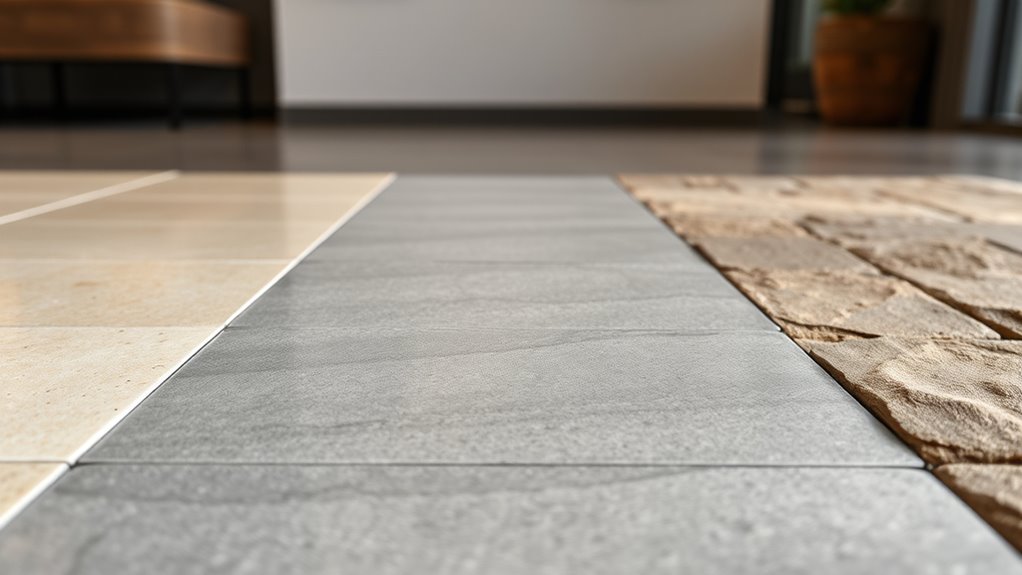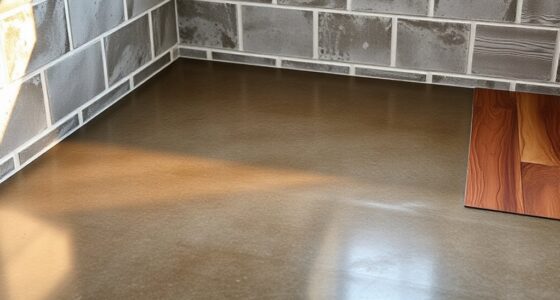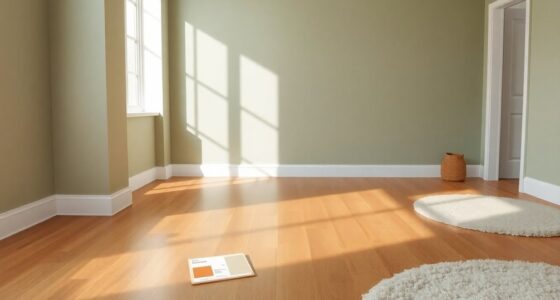When choosing tile flooring, consider your needs: ceramic tiles are budget-friendly and easy to install, perfect for low-traffic areas, while porcelain tiles are denser, more durable, and ideal for outdoor or high-traffic use. Stone tiles offer natural beauty and elegance but require regular sealing and maintenance. Each type has unique benefits and challenges, so understanding these differences can help you select the best fit. Keep exploring to discover which options suit your space best.
Key Takeaways
- Ceramic tiles are affordable and easy to install but less durable than porcelain and stone.
- Porcelain tiles are denser, more water-resistant, and ideal for high-traffic and outdoor areas.
- Stone tiles offer natural beauty and elegance but require sealing and regular maintenance.
- Installation for porcelain and stone needs specialized tools and skills, while ceramic is simpler.
- Choose based on location, durability needs, aesthetic preference, and maintenance capacity.

Are you considering tile flooring for your space? If so, understanding the differences between ceramic, porcelain, and stone tiles can help you make an informed decision. Each type offers unique benefits and challenges, especially when it comes to installation tips and maintenance routines. Ceramic tiles are popular for their affordability and ease of installation. They come in a wide variety of colors, patterns, and finishes, making them versatile for both walls and floors. When installing ceramic tiles, you should pay close attention to proper surface preparation. Ensure the subfloor is level, clean, and dry before laying tiles to prevent cracking or uneven surfaces. Using the right adhesive and grout is also essential for a durable finish. After installation, maintaining ceramic tiles is straightforward; regular sweeping and damp mopping with mild cleaners keep them looking their best. Avoid harsh chemicals that can damage the glaze, and periodically reseal the grout lines to prevent staining and moisture penetration.
Porcelain tiles are a step up in durability and water resistance, making them ideal for high-traffic areas and outdoor spaces. Their dense composition means they’re less porous than ceramic tiles, which adds to their longevity. When working with porcelain, follow specific installation tips such as using a high-quality thin-set mortar and a notched trowel suited for dense materials. Because porcelain tiles can be harder to cut, having the right tools, like a wet saw with a diamond blade, simplifies the process. Proper installation is essential for preventing tiles from cracking or loosening over time. Maintenance routines for porcelain are equally easy; routine sweeping and mopping keep them pristine. Because they resist stains and moisture well, you don’t need to reseal them often, but checking for any chips or damage periodically helps maintain their appearance and integrity.
Stone tiles, on the other hand, offer a natural, elegant look but require more careful handling and upkeep. They can be made from marble, granite, slate, or limestone, each with different characteristics. When installing stone tiles, it’s crucial to use a suitable adhesive and to follow precise installation tips to avoid cracking and ensure proper bonding. Sealing stone tiles after installation is essential because many types are porous and can stain easily. Maintenance routines involve regular sealing—often every 6 to 12 months—along with gentle cleaning using pH-neutral cleaners. Avoid acidic or abrasive substances that can damage the stone’s surface. With proper care, stone tiles can last for decades, but neglecting maintenance can lead to staining and deterioration.
Frequently Asked Questions
Which Tile Type Is Best for Outdoor Use?
When choosing tiles for outdoor use, you should consider outdoor durability and slip resistance. Porcelain tiles are your best bet because they’re dense, water-resistant, and withstand weather changes well. They also offer slip-resistant surfaces, making them safe for outdoor areas. Ceramic tiles might work but aren’t as durable or resistant to moisture. Stone tiles can look great but may require more upkeep for outdoor durability and slip resistance.
How Do I Maintain and Clean Different Tile Types?
You should follow specific cleaning routines and maintenance tips for each tile type to keep them looking their best. For ceramic tiles, sweep regularly and mop with warm water and mild detergent. Porcelain tiles require similar care but are more resistant to stains, so occasional deep cleaning works well. Stone tiles need gentle cleaning with pH-neutral solutions and sealing to prevent damage. Regular upkeep guarantees your tiles stay beautiful and durable over time.
Are There Eco-Friendly Tile Options Available?
Imagine transforming your space with tiles so eco-friendly, they could save the planet! Yes, you can find options made from recycled materials that reduce waste and are stunning to look at. Plus, there are low VOC options that keep indoor air fresh and healthy. By choosing these environmentally conscious tiles, you’re not just decorating — you’re making a difference, one beautiful, sustainable step at a time.
How Do I Repair Cracked or Damaged Tiles?
When you notice cracked or damaged tiles, start with grout repair to see if the cracks are minor. For bigger issues, you’ll need to carefully remove the damaged tile using a chisel and hammer. Then, replace it with a matching tile, applying fresh grout to secure it. This process restores your floor’s appearance and prevents further damage, keeping your space looking fresh and well-maintained.
What Is the Typical Lifespan of Each Tile Type?
When considering tile longevity, you’ll find that ceramic tiles typically last 20-40 years, offering solid durability for standard use. Porcelain tiles are more durable, with a lifespan of up to 50 years or more, thanks to their dense composition. Stone tiles, while beautiful, generally last 30-50 years but require more maintenance. Your choice depends on your durability comparison needs and how much wear and tear the area will endure.
Conclusion
In the end, choosing the perfect tile might seem intimidating, but don’t worry—you’ll probably end up with a beautiful floor regardless. Whether you pick ceramic, porcelain, or stone, each has its quirks and charms. So, go ahead, spend hours debating the pros and cons—because, really, your choice won’t make or break your home. After all, it’s just tile. Or is it? Either way, you’re covered!









